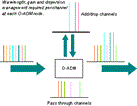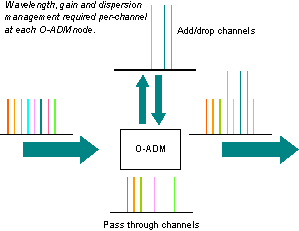The Five Pillars of Next-Gen Optical Networks

Contents
Scalability
Transparency
Tunability
Manageability
Packaging and assembly
A world of opportunity
I enjoyed reading the Fiber Optics Online editorial by Mark Lutkowitz (Trans-Formation), titled Metro DWDM Rhetoric Fails to Win Contracts. The theme of Mark's piece—that dense wavelength division multiplexing (DWDM) technologies remain too expensive and inflexible for general deployments in local networks—complements the foundation of our thinking on optical networking at TeleSoft Partners. The sentiment also explains why we're excited about this space from a venture investor perspective: So much remains to accomplish, and so much opportunity exists for innovators and their capital suppliers.
We identify five fundamental pillars of development for next-generation optical networking equipment: scalability, transparency, tunability, manageability, and packaging, and assembly. These pillars support the foundation of next-generation solutions, and technology pursuits based upon one or more of these pillars provide the most attractive opportunities for investment payback.
What follows, then, are brief characterizations of these five pillars and their relevance to directions in optical networking. In subsequent articles, we'll dig into these areas more deeply, and highlight some of the more impressive efforts in each case.
Scalability
Addressing the cross-issues of expandability and cost containment is scalability. WDM systems suppliers traditionally have competed on channel count or throughput, pushing their claims into hundreds of channels and terabits of bandwidth. While carriers want assurances that their new systems can expand to these capacity densities when necessary, network operators report that they have few systems configured beyond 40 channels in operation today. Of greater near-term importance than heroic capacity to carriers, particularly to local operators, is low initial installation cost.
Industry experts routinely criticize metro WDM solutions offered by incumbent suppliers for being little more than scaled-down versions of long-haul systems. The fairness of this blanket accusation varies by supplier, but all the incumbent manufacturers have designed their metro products on same underlying platforms as their long-haul systems.
An incumbent local exchange carrier (ILEC) using just four of the 32 available channels in one of these metro systems may save initial capital outlays on channel cards, but the carrier still pays for the full 32x1 optical multiplexing fabric and accompanying optics, even though it initially uses only 1/8th of the system's capacity. Newer market entrants are introducing products that modularize the multiplexing fabric in addition to the channel cards. This modularity supports lower life cycle costs and tracks the timing of carrier investments more closely to capacity utilization. This enhanced level of scalability lowers the cost equation materially for metro WDM investment, and should help jump-start the adoption of this technology at the local level.
Transparency
Current WDM systems are dumb devices with static operations. "Dumb" is not meant to trivialize the extraordinary challenges overcome by developers of current generation equipment. But face it—WDM end terminals are the optical reincarnation of time division multiplexing (TDM) channel banks. WDM terminals mux up and demux down, but provide little dynamic control over operations. The transparent (all-optical) segments of current WDM networks are configured in line architectures only. In instances where WDM terminals reside on physical rings, the networks become opaque at ring nodes, where synchronous optical network add/drop multiplexers (SONET ADMs) feed circuits on and off the rings electrically.
Let's not be ungrateful to SONET ADMs and digital cross-connects (DCSs). The high level of dependability taken for granted with the public telephone network is due largely to the dynamic nature of SONET and digital cross-connect (DCS) systems, and their supporting management systems. Functions such as Automatic Protection Switching, Dynamic Bandwidth Allocation, drop-and-continue, and circuit grooming permit real-time, automated changes in network transmission configurations. These features also enable network survivability over ring and mesh architectures.
But in the hybrid optical/electrical world of opaque networks, optical-to-electrical conversions at ADM and DCS nodes introduce failure points, require substantial power, slow down traffic processing, and take up precious real estate. All-optical systems are being developed to resolve these issues.
The realization of truly transparent networks is a non-starter without the availability of optical switch fabrics. Optical switching facilitates the flow and routing of terabits of traffic on optical networks. Agnostic to the protocols and services passing through them, optical switches will support the service provider goal of operating an integrated, multi-service (voice, data, and video) network.
Much effort is being directed at compact (card-, and eventually chip-size) photonic crossbar switches that dynamically interconnect wavelength channels and easily integrate into systems architectures. All-optical switches based on the mechanical alignment of mirrors or fibers have been available for years, but these switches are too bulky for large telecom systems, which eventually must scale beyond 1,000 ports (optical channels).
Leveraging years of development work for printer and display applications, commercial introductions of micro-mechanical reflectors and liquid crystal switches will begin next year. Work in other solid state switching materials, such as LiNbO3 and polymers, continues on a number of fronts. The integration of these devices into commercial communications systems will mark a significant milestone for next-generation optical networks.
Tunability
True optical networking requires all-optical ADMs (OADMs) and cross-connects (OXCs) that replicate the utility of their electrical counterparts, SONET ADMs and DCSs. Fundamental to these all-optical network elements is the tunability of critical optical parameters, including wavelength, dispersion, and gain.
Wavelength tuning allows rapid network reconfiguration and promotes efficient reuse of wavelength channels that are dropped at ring nodes. Tunable lasers also reduce sparing and inventory costs substantially, given that a single tunable back-up laser can support up to a dozen operating lasers.
Tuning of dispersion and gain is also required at OADMs, given that fresh light channels entering a network at the OADM will tend to have higher power and less noise than pass-through traffic at the node. These imbalances degrade network performance. Dynamically equalizing the dispersion and gain mitigates the problem (see Figure 1).

Manageability
There is no "networking" in "optical networking" today. Current products offer loads of bandwidth, but little intelligence and no network-wide view of operations.
For an analogy, imagine flying NoView Airlines from San Francisco to Paris—with stops in Chicago and New York. Because NoView has no network-wide system for monitoring and managing its flights, you must disembark from the plane at each stop, retrieve your suitcases at baggage claim, buy a new ticket for the next leg, recheck your bags, and reboard the plane. The process is slow, and you don't know the status of seat or even flight availability ahead of each leg. Hopefully you got a low fare.
Next-generation optical platforms require network management and operational support systems (OSSs) that track wavelengths, not just electrical circuits, as they traverse through various nodes (optical add/drops, switches and routers) in a network. They would enable wavelength-based service provisioning, which opens a new set of service possibilities for carriers.
Bellcore (now Telcordia Technologies) developed most of the OSSs operating throughout RBOC networks today—such as TIRKS (Trunks Integrated Record Keeping System) and NMA (Network Monitoring and Analysis)—years before WDM came along. The concept of "lambda circuits" was not a consideration then, and the OSSs cannot easily adapt to wavelength-class circuit management. Fundamentally different management and support platforms are required.
How different, really, are the management needs of optical networks? Consider performance monitoring, which is just one of many elements in a complete management platform. Performance monitoring in current networks measures performance in bit error rates (BER), with "bit" being the operative word. This measure assesses, enhances, and leverages network health and quality of service (QoS) for varying service rates.
All-optical networks don't have bits; they have wavelengths, which are inherently analog in nature. The metrics that characterize optical channels, such as optical power distribution, dispersion, polarization, and wavelength, do not apply to electrical circuits. Because transparent networks remain optical through various routing, amplifying, and switching nodes, the networks offer no convenient locations for extracting BER information from traffic in the wavelength channels until the traffic reaches a termination point at the network edge.
Several companies are introducing operational support and network management systems that are optimized for all-optical networks, but it will take years for ubiquitous deployment of these solutions in the public network.
Packaging and assembly
Current optical assemblies used in WDM systems more closely resemble breadboard circuit experiments in a first-year electrical engineering class than tightly integrated channel cards common to electrical network systems. Just as students' breadboards contain various resistors, capacitors, and other discretes kluged together with electrical jumper wires (I'm dating myself, I know), optical modules connect discrete components with optical fibers, or pass light between components through free-space. Either way, a lot of manual alignment and securing is needed, which introduces opportunities for failure and inhibits the use of automated fabrication and assembly techniques common to the semiconductor industry.
Component suppliers like JDS Uniphase and E-Tek Dynamics have made tremendous strides in the packaging density of their integrated modules. Still, the high degree of manual intervention required to assemble each module penalizes the manufacturer's ability to realize the benefits of scale under exploding demand for their products.
The Holy Grail of packaging for the components industry is monolithic fabrication of various functions—such as multiplexing, switching, amplification, and even light generation—in a single block of solid state materials. Efforts to accomplish this are underway, but pure monolithic planar light chips (PLCs) containing lasers remain at least two years from commercialization, and you can add another year for telco qualification.
In the near term, companies are bringing hybrid devices to market. These devices feature passive processing (multiplexing and component connection), realized in waveguides grown through standard epitaxial techniques, as well as discrete active devices secured in pre-aligned wells in the chip. Automated fiber welders may be used to fix fiber pigtails to these devices. While planar hybrids are not the end game of true monolithics, the hybrids do lend themselves to automated pick-and-place machines that reduce the human assembly element and enhance the benefits of scale.
A world of opportunity
As we close out the 90s and assess the changes in network technologies during the decade, the migration to optical networking stands among the most significant events. Certainly from an investor's perspective, opportunities afforded by this development have been tremendous.
Consider the returns generated by early investors in Ciena, JDS Fitel, Uniphase, E-TEK Dynamics, OCLI, and SDL, to name just a few. Picking the winners isn't easy, but that's part of the fun. And the need for continued innovation—the development of our five pillars—will sustain the opportunities for bright minds and their backers.
About the author…
Fiber Optics Online guest columnist William Magill is a vice president at TeleSoft Partners. His e-mail is bill@telesoftvc.com.
